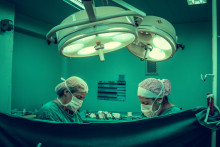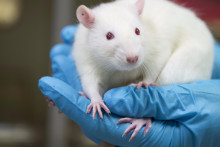Pioneers in Health Care fund
The Pioneers in Health Care (PIHC) fund, founded in 2014, is a collaboration between the University of Twente, Saxion, Medisch Spectrum Twente (MST) in Enschede, ZGT in Hengelo and Almelo, Deventer Hospital and, as of this year, Reggeborgh Medical. Each year, the funding is awarded to joint projects focused on improving healthcare in the East of the Netherlands. Every project receives approximately € 60.000 and should last a year.
The awarded projects have covered a vast range of topics, but they all try to solve challenges faced by clinicians. Every year the fund organizes a matchmaking event for researchers and clinicians to meet and collaborate, explains Schuiling – Jukes. ‘It is important to do that, because you don’t want to push technology into clinics, not knowing if it’s truly useful and if the healthcare workers want it. At the same time, clinicians often see more possibilities for the technology than the researchers do. They help them look outside the box and think out of the scope of their original research idea.’
Treatment of melanoma
This is also the case for a project led by UT scientist Lejla Alic, who received the funding this year along with ten others. While her research normally focuses on breast cancer, the PIHC study is directed at treatment of melanoma. ‘The idea to start a melanoma project came directly from the patient organization,’ says Alic. ‘We already do research into metastatic lymph nodes in breast cancer and we realized that we can translate our knowledge into tailoring melanoma treatment, because both melanoma of upper extremities and breast cancer potentially metastasize trough the axilla.’
The project, with the full title ‘MR lymphography and magnetic sentinel lymph node biopsy in melanoma patients’, focuses on technical development for detection of cancer metastasis. ‘Cancer patients nowadays don’t often die from the primary tumor but usually from metastasis,’ explains Alic. ‘At the same time, the number of melanoma incidents is exploding nowadays and melanoma of the skin has a strong tendency to metastasize. There is therefore an obvious societal need to address this issue.’
Device for surgeons
‘Our goal is to help surgeons find and remove the metastatic lymph nodes,’ continues the researcher. ‘To resect metastatic lymph nodes, surgeons currently have to remove all lymph nodes they find – because you don’t know prior to the surgery which ones need to be removed. However, the less you resect the better, because the lymph nodes have a function. We therefore want to remove only the one that is metastatic. We will use preoperative MRI enhanced by magnetic nanoparticles to identify the metastatic lymph nodes and, at the same time, we are working on a handheld device that will guide a surgeon towards the metastatic lymph nodes.’
Access to patients
Thanks to the PIHC, all of the above will already happen in the coming year – during clinical pilot in Twente-based hospitals MST and ZGT. ‘Direct access to patients is a big advantage and one of the reasons we applied for the funding,’ says Alic.
The PIHC project manager Schuiling – Jukes also sees this as one of the main pros of the fund. ‘The active collaboration with hospitals gives us more access to patients. For example, last year there was a project to design a wearable trainer for children with asthma. We could ask children to try it and wear it and then give their feedback – was it easy for them play in, could they run, did they like the colour? These are the details that determine whether the patients will actually embrace the technology. We see that in almost half of the projects patients are already involved in the research. This can mean that they give feedback on the design, test the development of an app, or that an orthopedic surgeon uses their data to prepare 3D simulations or molds before surgery.’
Kick starter
Clinical implementation is the primary goal of all the PIHC projects. Out of the seventy studies from the past seven years, how many of them made it to hospitals, though? ‘That is hard to say,’ replies Schuiling – Jukes. ‘An example that I currently know of is a new measuring device for sleep apnea that patients can wear at home. This is already widely used. Another example is the interactive playground to stimulate activity of asthma patients at MST. The first results were very positive, and the project continues into the development of an app so the children can play at home and into a playground for children who have trouble with balance and coordination.’
‘The reason why I can’t give a long list of examples of widely used clinical applications yet is simple,’ continues Schuiling – Jukes. ‘Each project receives 60.000 euros and should last about one year, but this funding is essentially seed money, it is a kick starter. Often more research is required to optimize the prototype, perform clinical studies, or attract new funding to continue the research. What we see is that most projects use the seed money from the PIHC voucher to establish the first results or data set, which can be used for a proposal for new funding, for example large national grants from NWO or TTW, or even EU grants.’
Data sets
This is also precisely what Lejla Alic intends to do. ‘The goal of the one year project is to acquire a dense data set. We will be working with about twenty patients in MST and ZGT. We will start clinical tests using the surgery device, injecting nanoparticles and MRI imagery. We want to learn how to characterize the lymph nodes and start to learn about an automatic method to identify metastasis. But in order to build any sort of AI or another method, we need data first. We will therefore be building data sets that we could use for years, also for other projects. With the data sets, we can also set up larger studies.’
‘Let’s give them a chance’
‘About 80% of our projects attracted new funding and are continuing,’ says the project manager. ‘Fortunately, we see that most of the researchers and clinicians still collaborate, even years after their awarded PIHC voucher. We expect more clinical implementation in the coming years. Yes, some projects failed. Perhaps because the technology could not be developed or did not work as hoped, or because clinicians indicated that it would not be feasible to implement it in the hospital or it would be too expensive. Of course, it is unfortunate when you don’t get positive results, but it is part of the pioneering approach: some will fail, and some will succeed. Every year there is a project of which the assessment committee will say: if this works, it will make a huge change in patient’s lives, but we don’t know if it will work. Let’s give them a chance.’







